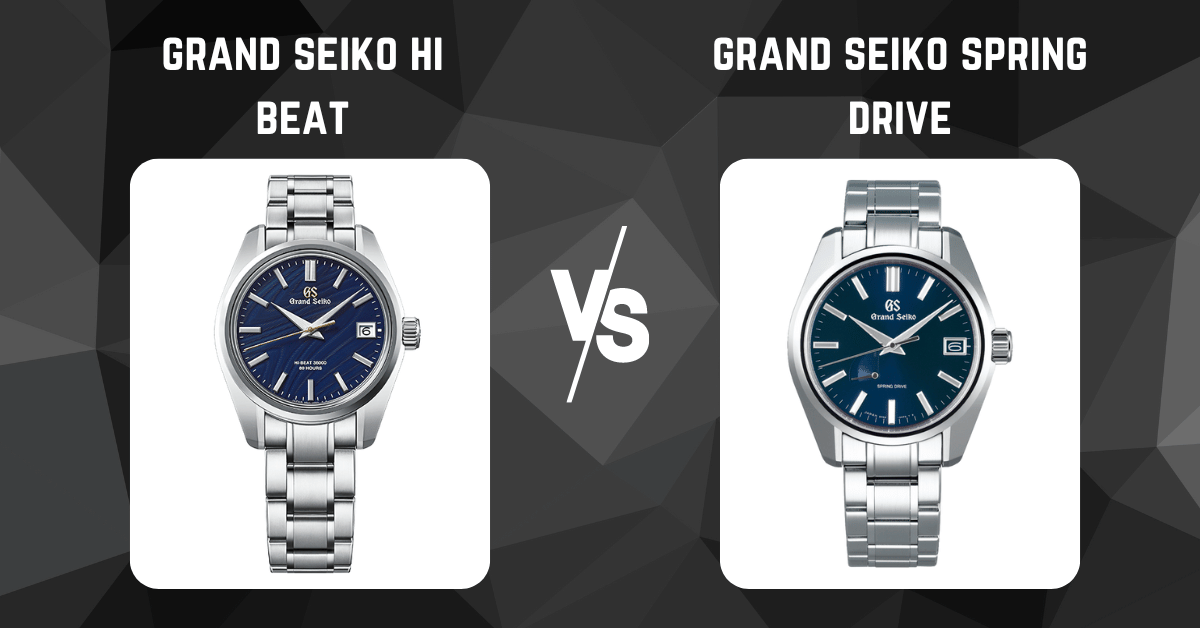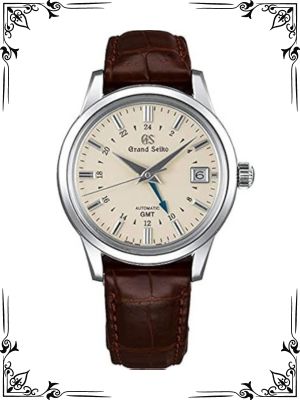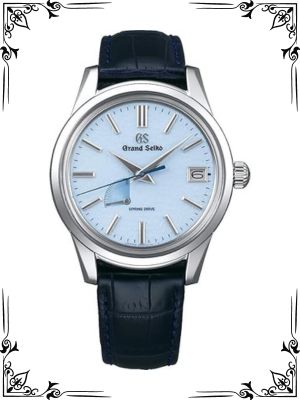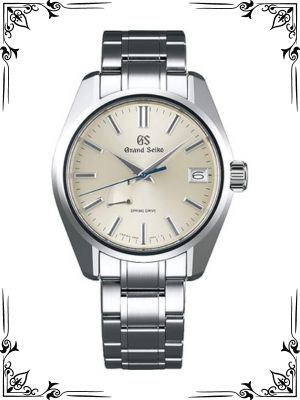Traditional mechanical movement with high accuracy (+5 to -3 seconds per day) and a captivating ticking sound. Offers a classic watch experience. Revolutionary hybrid movement combining mechanical and quartz technology, achieving phenomenal accuracy (+10 seconds per month) and a smooth sweep of the second hand.
Introduction
Choosing a Grand Seiko is a journey to the pinnacle of Japanese watchmaking. But within this elite brand, you face another critical decision: Hi-Beat or Spring Drive. Both movements boast exceptional craftsmanship and accuracy but cater to different preferences. Let’s delve deep into their unique characteristics to help you pick your champion.
Congratulations! You’ve set your sights on a Grand Seiko, a testament to precision and timeless design. Now, you’re captivated by two exceptional movements: the Hi-Beat and Spring Drive. Both deliver on Grand Seiko’s promise of unparalleled quality, but each offers a distinct personality.
This guide will equip you with the knowledge to make an informed decision, aligning your watch with your personal style and watch preferences.
History
Understanding the history behind these movements adds another layer to your appreciation.
Hi-Beat: Debuted in 1968, the Hi-Beat ushered in a new era of high-frequency mechanical movements. Grand Seiko’s Caliber 4S55 vibrated at a groundbreaking 36,000 beats per hour (bph), surpassing the industry standard of 28,800 bph. This innovation translated to superior accuracy and a smoother sweeping motion of the second hand.
Spring Drive: Unveiled in 1991, Spring Drive defied categorization. It combined a traditional mainspring with a revolutionary tri-synchro regulator employing a quartz crystal and an electromagnetic brake. This ingenious blend resulted in a movement with the soul of a mechanical watch and the near-perfect accuracy of quartz.
Technical Breakdown
Now, let’s get under the hood and explore the technical intricacies of these movements.
Movement:
| Feature | Hi-Beat | Spring Drive |
|---|---|---|
| Type | Mechanical (automatic or manual wind) | Hybrid (mechanical and quartz) |
| Accuracy | +5 to -3 seconds per day | +10 seconds per month |
| Power Reserve | Typically 50-55 hours | Typically 72 hours (some models reach 120 hours) |
| Escapement | Traditional Swiss lever escapement | Tri-synchro regulator |
| BPH | 36,000 (Hi-Beat) | N/A (doesn’t use a traditional escapement) |
| Second Hand Movement | Ticking motion | Glides smoothly |
Spring Drive’s accuracy is truly remarkable. Imagine gaining only a maximum of 10 seconds in an entire month! The Hi-Beat, while less precise, still outshines most mechanical watches. Both movements boast impressive power reserves, ensuring your watch keeps ticking even after you take it off for the night.
Materials and Construction:
Both movements are meticulously crafted using high-grade materials and Grand Seiko’s signature zaratsu polishing, resulting in a flawless finish. However, some subtle differences exist:
- Hi-Beat: Relies on traditional watchmaking components like a balance wheel and escapement, requiring specialized watchmakers for servicing.
- Spring Drive: While still intricate, the movement incorporates a quartz crystal and an electromagnetic coil, potentially increasing servicing complexity.
Functions and Features
Both movements offer core timekeeping functions, with some models featuring additional complications like date, power reserve indicator, and GMT hand. However, the core difference lies in the experience they deliver.
The Hi-Beat offers the classic mechanical watch experience with a satisfying ticking sound and the intricate dance of the balance wheel visible through the exhibition case back. Spring Drive, on the other hand, provides a mesmerizingly smooth sweep of the second hand due to its glide wheel.
Design and Aesthetics
Design:
Grand Seiko offers a wide range of dial designs for both movements. Hi-Beat models often feature a classic, legible layout, while Spring Drive models may incorporate a power reserve indicator or a slightly more modern aesthetic. Ultimately, the choice boils down to your personal preference.
Case and Bracelet:
Similar to dials, both movements come housed in a variety of case materials and bracelet options. Grand Seiko is renowned for its diverse offerings, from sporty stainless steel to luxurious precious metals like titanium and platinum.
Brand Image:
Hi-Beat is often associated with the heritage and tradition of mechanical watchmaking. It appeals to purists who appreciate the intricate mechanics and the history behind this technology. Spring Drive, on the other hand, embodies Grand Seiko’s innovative spirit. It caters to those seeking a watch that pushes boundaries and offers a unique, cutting-edge experience.
User Feedback
Here’s what real-world Grand Seiko owners have to say:
Hi-Beat:
- “The Hi-Beat has a soul. You can feel the engineering marvel on your wrist with each tick.”
- “I love the classic look and the satisfying sound of the ticking. It reminds me of the craftsmanship that went into making this watch.”
- “While the accuracy is impressive, Spring Drive’s near-perfection is hard to ignore.”
Spring Drive:
- “The smooth sweep of the second hand is mesmerizing. It truly sets Spring Drive apart.”
- “The accuracy is mind-blowing. I never have to worry about my watch losing time.”
- “While I appreciate the heritage of Hi-Beat, Spring Drive feels like a glimpse into the future of watchmaking.”
Ultimately, user feedback emphasizes the subjective nature of the choice. Both movements have passionate advocates who appreciate their distinct qualities.
Common Problems
Both movements are renowned for their reliability, but even the finest engineering can face occasional hiccups. Here’s a breakdown of potential issues:
Hi-Beat:
- Regulation: Like any mechanical watch, the Hi-Beat may require periodic regulation to maintain optimal accuracy.
- Shock Resistance: While robust, Hi-Beat movements might be slightly more susceptible to damage from severe shocks compared to Spring Drive due to the intricate escapement.
Spring Drive:
- Servicing: Due to its unique hybrid nature, servicing a Spring Drive may be more expensive and require a watchmaker with specialized training.
- Quartz Dependence: While still incredibly reliable, Spring Drive relies on a quartz crystal for its accuracy. Some purists might view this as a departure from the pure mechanical experience.
It’s important to remember that these are potential issues, not guaranteed occurrences. With proper care, both movements can provide years of trouble-free service.
The Final Lap: Choosing Your Champion
Now that you’re armed with in-depth knowledge about Hi-Beat and Spring Drive, it’s time to make the final call. Here are some questions to guide your decision:
- Do you prioritize traditional watchmaking or cutting-edge technology?
- Does the satisfying tick of the Hi-Beat resonate with you, or does the smooth sweep of Spring Drive hold more appeal?
- How important is absolute accuracy to you?
- Do you value a classic, timeless design or a more modern aesthetic?
- Consider your budget and any potential servicing costs associated with each movement.
There’s no right or wrong answer. The best choice hinges on your personal preferences and watch-wearing habits.
Conclusion
Whether you choose the Hi-Beat’s mechanical heart or Spring Drive’s revolutionary spirit, you’re selecting a masterpiece from the world of Grand Seiko. Both movements represent the pinnacle of Japanese watchmaking, offering exceptional accuracy, stunning craftsmanship, and timeless design.
Ultimately, the perfect Grand Seiko is the one that speaks to your soul and complements your style. So, take your time, explore the various models available, and let your watch guide you on a lifelong journey of appreciation for exceptional timekeeping.
FAQs
1. Which movement is more expensive?
Generally, Spring Drive models tend to be slightly more expensive than their Hi-Beat counterparts. However, prices can vary depending on specific models, complications, and materials used.
2. Can I see the Spring Drive movement?
While some Hi-Beat models feature exhibition case backs showcasing the intricate mechanics, Spring Drive movements are typically encased due to their unique construction.
3. Is Spring Drive considered a true mechanical watch?
This is a matter of debate among watch enthusiasts. Spring Drive incorporates a quartz crystal but still relies on a mainspring for power, blurring the lines between mechanical and quartz technology.
4. How often does a Grand Seiko need servicing?
Grand Seiko recommends servicing every 3-5 years depending on the model and usage.
5. Where can I buy a Grand Seiko?
Authorized Grand Seiko retailers are the best option to ensure authenticity and proper guidance. You can also explore the brand’s official website for a dealer locator.




